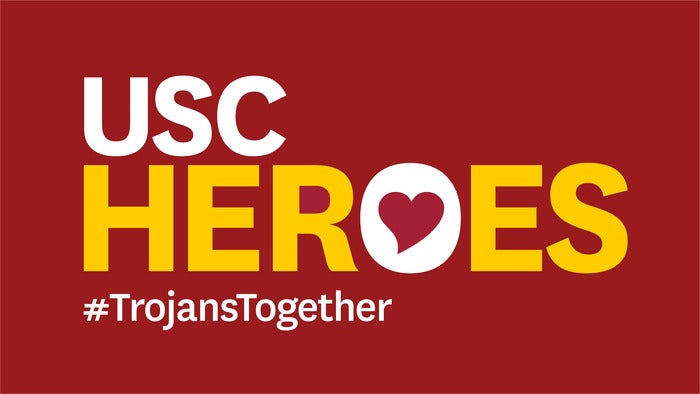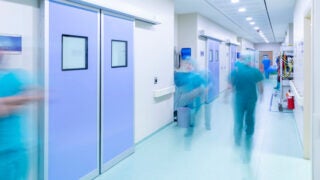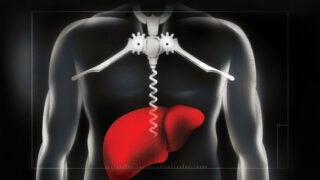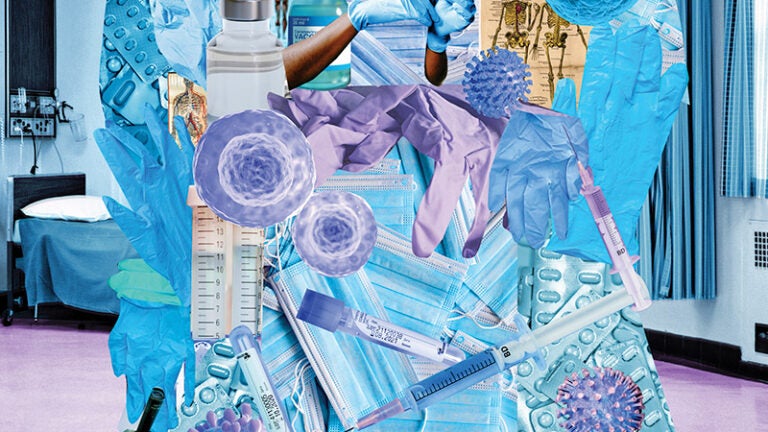
(Illustration/Johanna Goodman)
How USC Health Experts Jumped into Action to Fight COVID-19
Trust the science. Follow the data. Keck Medicine of USC confronts the coronavirus pandemic with strategies centered on rigorous research.
If there is one constant in the COVID-19 health crisis, it’s change.
“The biggest challenge all along has been the unknowns—managing the many manifestations of this disease as it was spreading rapidly,” says Hugo R. Rosen, the Kenneth T. Norris Jr. Chair in Medicine at the Keck School of Medicine of USC. “As a medical community, no one was really prepared for the scope of the problem or the natural history of the disease; for example, how long patients would need ventilatory support. However, we’ve learned from colleagues around the world and have a much greater grasp of the best clinical management.”
Forced to make high-stakes decisions with rapidly evolving and often conflicting information, medical professionals at Keck Medicine of USC followed a simple rule: Trust the science and follow the data. It kept them grounded and optimistic at a difficult time.
Although their work is far from done, here’s a look at how USC’s health experts tackled one of the biggest threats faced by modern medicine.
USC Sets Strict Standards in COVID-19 Response
It took scientists less than 12 months to speed from identifying the new coronavirus to developing and testing an effective vaccine. That smashes the previous record of four years, the time it took to create a vaccine against the mumps in the 1960s. The feat merits the often-used word “unprecedented.”
But the appearance of SARS-CoV-2, the virus that causes COVID-19, was “neither unprecedented nor unexpected,” says Edward Jones-López, a Keck School of Medicine infectious disease expert. “We’ve been waiting for the next pandemic for 30 to 40 years.”
As soon as news broke in December 2019 that a potentially deadly virus had emerged in Wuhan, China, scientists recognized the seriousness of the threat and scrambled to respond.
Two decades of research into developing robust vaccines safely — identifying the best targets, delivery methods, what we needed to do and how — crystallized in this moment in history.
Edward Jones-López
“Two decades of research into developing robust vaccines safely—identifying the best targets, delivery methods, what we needed to do and how—crystallized in this moment in history,” Jones-López says.
Neha Nanda was charged with drawing up protocols that would enable Keck Medicine to treat patients during the pandemic and ensure employees could work safely. As medical director of infection prevention and antimicrobial stewardship, she embraced a guiding principle: “Whatever we do has to be based in scientific evidence.” She knew the situation would evolve as USC health experts figured out more about the virus. “We were learning things by the hour in the early days,” Nanda says. “This put to the test our nimbleness as a health system.”
USC was one of the first medical centers in Los Angeles County to mandate face masks for everyone, whether in its clinics or offices. It was also among the first nationwide to implement COVID-19 testing for all people admitted or transferred to its hospitals. Nanda oversaw detailed battle plans for USC’s COVID-19 response that designated specific operating rooms, elevators and treatment areas for virus-positive patients and included buffer zones between COVID-19 and non-COVID-19 sections. A team ensured a medical evaluation tent quickly rose outside Keck Hospital of USC to triage patients.
Rod Hanners, Keck Medicine’s interim CEO, emphasized how seriously the health system viewed the situation: “Since the beginning, the safety of our staff, physicians and patients drove all our decisions. We were far more conservative with our health and safety protocols than required by regulatory and advisory organizations. A perfect example was maintaining a higher level of protection with the use of N95 respirators.”
Keck Medicine faced the same shortages of personal protective equipment that initially plagued many medical centers. USC health officials also recognized the need to ramp up COVID-19 testing capabilities early on in their response. The leadership team convened daily to develop strategies for these issues and others.
Complicating decision-making, the Centers for Disease Control and Prevention’s guidance on COVID-19 transmission fluctuated weekly. At one point, the federal agency said the virus was transmitted only by respiratory droplets that quickly fell to the ground. “We did not back off our belief this virus could be airborne and travel much farther distances,” Nanda says. Later, the agency amended its advice.
By spring 2020, with community infection rates rising, Nanda’s team tested more than 2,900 USC health workers in four weeks. Only 0.17% tested positive, compared to the average community rate of 5% to 8%. The safety measures were working. The team replicated its safety protocols at all Keck Medicine facilities.
To further protect its frontline staff, Keck Medicine offered free temporary housing for employees who wanted to stay away from home to safeguard loved ones from possible exposure. It’s part of Keck Medicine’s Care for the Caregivers program, which also offers emotional and family support. Every day, health professionals could debrief with therapists and talk with counselors over the phone.
“Our true north in all of this,” Hanners says, “has been the safety of our staff.”
At the same time, Keck Medicine patients needed to continue seeking care for other medical issues. Keck Medicine ramped up telemedicine visits so patients could safely meet with doctors remotely. USC health professionals expect to complete more than 150,000 video visits with patients in the 2020-21 fiscal year, up from about 53,000 last year—and a dramatic increase from the nearly 300 such visits in 2018-19.
USC Health Experts Prepare for the Long Haul
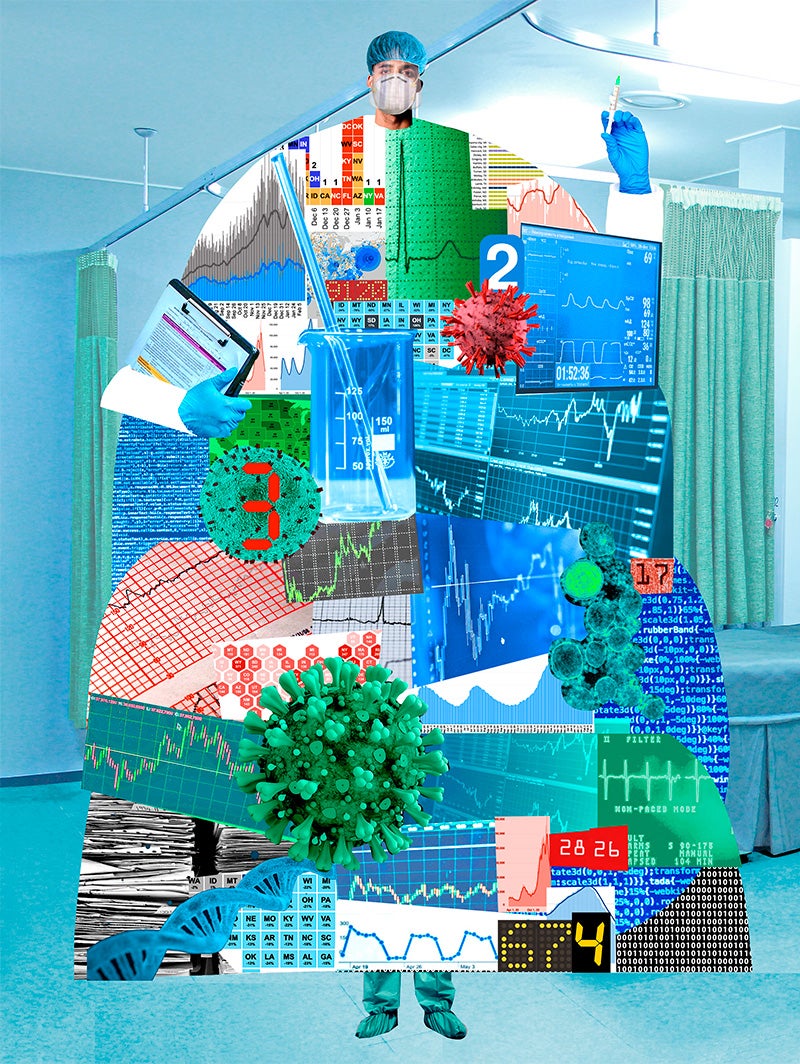
As health administrators focused on staff and patient safety, finding a vaccine for COVID-19 became the holy grail for researchers. In late summer 2020, USC began enrolling volunteers in a multicenter clinical trial to test an experimental vaccine developed by the University of Oxford and AstraZeneca, a biopharmaceutical company. To bring the vaccine’s potential benefit to those most at risk of infection and complications, the team especially sought out participants who were “essential workers,” such as people in factories, meat-packing plants and warehouses.
Before Oxford-AstraZeneca completed its clinical trial, two other vaccine makers—Moderna and Pfizer/BioNTech—gained emergency use authorization from the U.S. Food and Drug Administration. Both vaccines started being administered in the United States. But because they needed to be kept at super-cold temperatures, their availability was limited. The Oxford-AstraZeneca vaccine can be stored at warmer temperatures, and the United Kingdom began using it in December.
Jones-López, co-principal investigator of the Oxford-AstraZeneca trial at USC, is concerned that the success of the two front-runner vaccines will dampen interest in others, both in funding and participation. “It’s clear we’re going to need more vaccines and simpler vaccines if we’re going to get out of this pandemic,” he says. “This problem has to be addressed on a global basis.”
One lesson Keck Medicine doctors have learned is that COVID-19 is more complex and can affect people much longer than originally thought. To make sure we have the best array of options to defeat the virus, they continue to push forward with their vaccine and treatment research.
Last fall, USC recruited participants for a nationwide clinical trial of bamlanivimab, an experimental antibody drug for adults and children older than 12 at high risk of going to the hospital with severe COVID-19 symptoms.
Monoclonal antibodies are synthetic versions of natural antibodies—infection-fighting proteins made by the immune system that bind to viruses and prevent them from infecting cells. In early testing, the drug reduced hospitalization by 70%. It’s the first treatment to show promise for these high-risk patients.
COVID-19 can affect people much longer than originally thought. Keck researchers continue to push forward with their vaccine and treatment research to help “long-haulers” suffering from lingering effects.
Also of growing concern to doctors are “long-haulers”—often people who have mild to moderate cases of COVID-19 but can’t shake the symptoms months after falling ill. Experts are puzzled as to why this virus hits previously healthy adults so hard. Patients might go from running a marathon one day to feeling too exhausted to get out of bed a few weeks later. “One theory is that their immune system went into overdrive to protect them from the virus,” says Rosen, who studies human immunology. “But once it has been eliminated, the immune system remains activated, and this causes problems.”
Mirroring nationwide stats, about 10% of the COVID-19 patients at Keck Medicine are long-haulers, and most are between 20 and 40 years old. To help them, Keck Medicine launched L.A.’s first multidisciplinary recovery clinic in January. It’s open to patients whose symptoms linger past six weeks.
A core team of a primary care physician, pulmonologist and physical therapist assesses each long-hauler and develops an individual plan of care. Because lingering symptoms range from joint pain to brain fog, a navigator arranges appointments with specialists in areas such as cardiology, gastroenterology, infectious diseases, neurology, rheumatology, behavioral health, physical therapy and social work—all to treat the whole patient.
Keck Medicine Heads Toward a Post-Pandemic World
Even as Nanda directed hospitalwide safety efforts during USC’s response to COVID-19, she began treating people hospitalized with COVID-19. She remembers one early patient, a man in his 60s who grew sicker and sicker over five days, eventually ending up in the intensive care unit. Though his breathing became weak and ragged, after a week he began to get better. “I watched him leave the hospital to rejoin his family,” she says.
That memory became a beacon of hope for Nanda through the dark days to come. Too many of her patients—on ventilators, separated from loved ones—had no happy ending.
By December, however, it seemed like health care workers finally reached a turning point. Keck Medicine’s first Pfizer vaccine doses arrived. They brought with them optimism and relief for frontline employees, alongside detailed plans to roll out vaccinations for high-risk patients and community members.
We may not live in a COVID-free world, but we might get to live in a COVID-reduced world.
Neha Nanda
Other vaccine candidates are coming. More research will address unanswered questions about COVID-19. And as vaccinations, masks and other public health measures persist, infection rates will go down. Jones-López predicts more innovation throughout this year, fueled by a shared goal. Scientists are collaborative by nature, he says, and the unwavering global teamwork around COVID-19 “has been inspiring to see.”
Fresh challenges will undoubtedly emerge. USC officials plan to continue their COVID-19 response as they always do, Hanners says, “with a unified vision.” But experts warn that COVID-19 won’t be our last pandemic.
“We may not live in a COVID-free world, but we might get to live in a COVID-reduced world,” Nanda says. “This is our opportunity to be better prepared for the next one.”

